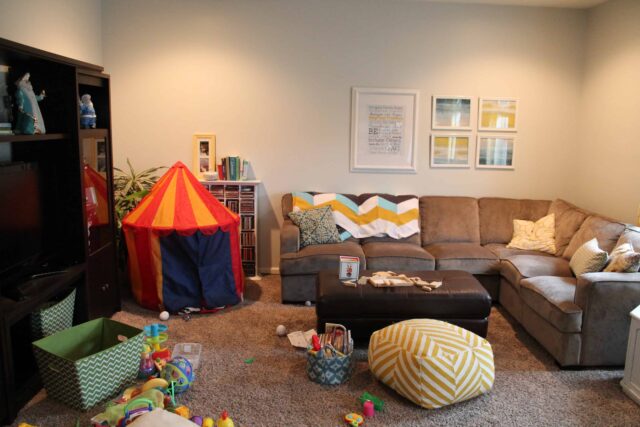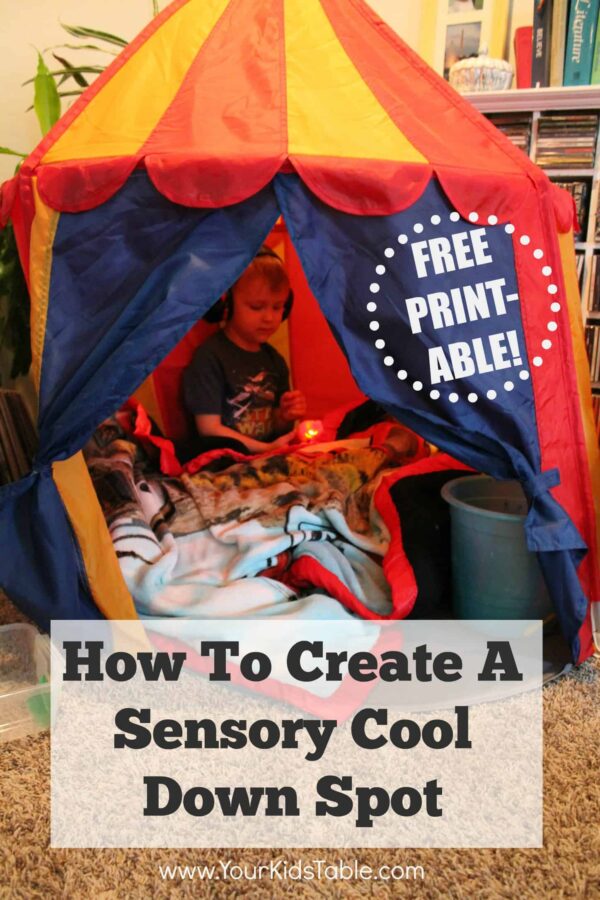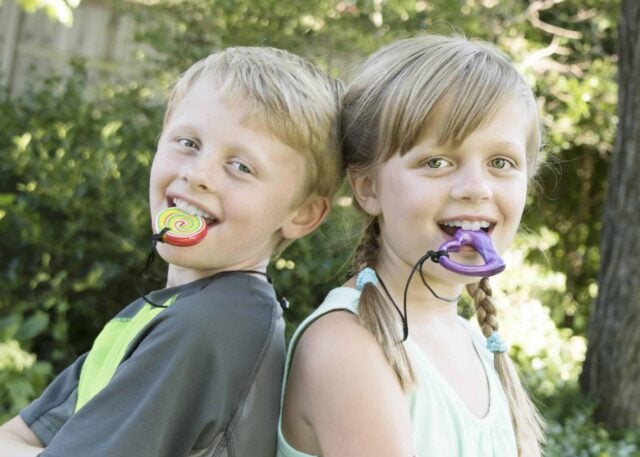Sensory tents can be amazing powerful tools to calm and organize children. I’ll give you quick and steps to set one up that will work in your home! Today’s post is brought to you by Chewigem USA. Affiliate links used below.
We have a lot of exciting things going on here today! I am very excited to be sharing with you one of my favorite sensory strategies: a sensory tent. Although it is certainly beneficial for many children with more obvious sensory needs, it can also be a valuable tool for kids in general, especially those that get frustrated easily, are sensitive, or display aggressive behaviors.
If you aren’t sure what a sensory tent is, another way to think about it might be a cool down spot. I’m going to walk you through all of that in more detail, and give you a plan for how to set one up in your home. (This could be a perfect gift for the holidays or birthdays, too!) AND, you can snag a one page printable of all the tips I share here at the end of this post!
Before I get into the Cool Down Spot specifics, I want to thank our sponsor, Chewigem USA. Chewigem is a family owned business that provides fashionable chewy jewelry and toys to meet the sensory needs of kids that like to chew. I can’t believe the amount of options they have! Kids can feel comfortable wearing the cool Chewigem products while chewing on a very safe and effective sensory tool. Win-win, right?
Let me also mention that throughout this post you will read lots of sensory suggestions. I will often highlight if a particular sensation or activity is calming or alerting. This is a general guideline and not a hard and fast rule. Sensory perceptions are very unique to every individual and can change from moment to moment or over time.
It’s important to experiment with your child and watch closely for their responses to the sensory input you are trying to offer.
If an activity that I sited as calming is actually revving your kid up, then you will want to shift gears. That doesn’t mean abandoning the activity altogether, but you may want to revisit it at another time. Lastly, if all this sensory stuff is new to you, make sure you check out my Sensory Basics page where I cover, well, all the basics! Okay, at last, on to the post…
What is a Sensory Tent?
A sensory tent, cool down spot, relaxation zone, or whatever term you choose to call it, is a dedicated space in your home (or classroom) that is calming and potentially provides various forms of organizing sensory input when your child is over-stimulated or upset. It is NOT a place for time-out! Sensory tents or quiet spaces are commonly used as part of a sensory diet, and most times children will initiate using the space on their own, which should be encouraged. The best sensory diet is a child advocating for their own needs. Of course, sometimes they need reminders if they are missing some of their own internal body cues.

Notice the simple design for this classroom, and barriers to help detract visual input. This may not be the best cool down spot or “chill zone”, but the teacher used what worked in her room.
Source: Unknown from Pinterest
This space is usually semi-permanent so that kids can depend on its location. There are numerous ways to set one up, everything from a small quiet corner to tents to closets, but the most beneficial way is to have it totally customized to your child’s needs. That may sound like a daunting task, but I’m going to take you through this step-by-step so this is an easy process, and so that it gives your child the maximum benefits.
How to Set Up a Sensory Tent
- Choose a location. There are a few factors to keep in mind when you are selecting a space to set up a sensory tent, and depending on the size of your home, you may have limited options. However, don’t be discouraged, there are lots of ingenious ways to incorporate sensory spaces into any home. When deciding on the location of your sensory tent, you will want to keep in mind two factors: noise level and size. Ideally, a quiet area in the house would be more calming, as loud and frequent noises are usually alerting and possibly disorganizing to the sensory system, which of course leads to over-stimulation or dysregulation. If square footage is an issue and the tent is in a louder place of the home, you will want to have ear phones available in the tent. As a bonus, the pressure from the headphones gives proprioceptive (deep pressure) and tactile (touch) input, which are typically calming sensations.

This is a picture of my living room, where my kids spend most of their time. It can get pretty chaotic in here, as you can see from the mess already brewing, and having that space where a child can visually take a break can be really important.
As you scroll through this post, you will see lots of examples of sensory tents or quiet spots, and there is one thing you will notice about all of them: They are small. A large space can be visually distracting, while a cave like environment invokes a sense of peace and calm as it shuts everything out. That is why just using your child’s entire bedroom as one giant cool down space usually isn’t as effective.
Source: Ikea
Choosing a small sensory spot as your child’s sensory “tent” also gives kids lots of spaces to push up against or crawl into. Doing so gives them deep pressure input, which is very calming. Many kids will seek those opportunities out on there own, as they crawl behind a couch, or in my son’s case, into the corner of the room behind a large house plant! If you see your child doing this, it is a good sign that they will respond well to a cool down space.
2. Decide on a structure, if any. As I have already mentioned, there are a lot of different ways to create a space, and while having a small tent that they can actually crawl into is ideal, similar results can be achieved in more creative ways. Take a look at some of my favorite ideas:
Source: Unknown, broken link on Pinterest

Source: Land of Nod
Source: Abundant Life Children

Source: Unknown, broken link on Pinterest
What type of structure you use will most likely hinge on your budget, physical space, and time to put it together. While I completely encourage you to start there, also keep in mind you child’s sensory needs. What types of sensations are they seeking? Do they like to swing? Then you may want to do something like the hammock in the example above. Do they like hugs and squeezing in between furniture? Then, a corner with a blanket over it, old-school fort style, may work well.
Source: Mosey Photography
At the same time, you will want to think about what types of sensations they are avoiding? Do they dislike a lot of noise? Then, having it be somewhere quiet will be more of a priority for you. Do bright lights bother them? Then an enclosed structure becomes more important.
3. Add blankets, pillows, cushions, and more. Sensory tents should feel cozy. The goal is to have your child unwind, to slow their engine, decompress. Having soft blankets and pillows helps to create that environment and of course, gives tactile and proprioceptive input.
As you saw in some of the examples above, you don’t have to stop at blankets or pillows, although this is something you probably have in your home already. There are lots of different types of chairs you can put into the space. If you decide to go that route, you will want to focus on seats that have rocking motions, slow swinging, or spinning as they are all generally calming sensations. Here is some inspiration for other seats to add in:

Source: Pinterest, Broken Link

Source: Flickr
Affiliate links used below. See our full disclosure.
4. Bring in the extras. This is the fun part! You need to have some calming sensory toys and accessories in the tent. Again, you will want to think about the types of input that calm your child. There is lots of sensory input that will be alerting, that is not the goal here.
One of my favorite things to include in a sensory tent is some type of chewy toy. Chewing is an extremely organizing activity, it is rhythmic and provides loads of proprioceptive (deep pressure) and oral input. If you have a chewer, that is why they are seeking the activity out, so lets meet that need! Place a chewy toy or chewy jewelry like this one in a small bin in the cool down spot:
I also really like to include something visual. This gives them something to focus on and allows them to decompress easier. Think about Christmas lights, flashlights, lava lamps, or the spinning light up toys. Having weighted blankets (get the entire guide to weighted blankets here) or pillows is another calming tool that is great to have in a sensory tent, and again is providing that deep pressure input. Vibrating toys are also very calming, and while there are lots of cool options available from sensory stores, simple handheld back massagers work well too.

Source: Pinterest, broken link (chair from Ikea)

Source: Sugar Aunts
I have mentioned headphones a few times, but wanted to make sure it was listed here too, as it can be a really important element. You can also use calming or rhythmic music, depending on your child’s response.
Lastly, a few different fidget toys that don’t have too many bells and whistles can help to calm and relax. There are hundreds of different options, but focus on simple ones like this one or these puffer balls. I like to gather all these items together and place them in shoe box sized container. I leave the box in the sensory tent and then the child can decide on their own what they need.
If you need more ideas to set up a sensory space, check out Awesome Sensory Room Ideas That Calm Kids.
Now you have all the steps and strategies to set up a custom sensory tent for your kiddo.
Get your Cool Down Space Printable for FREE! All you have to do is enter your email, check your inbox to confirm, and you will be redirected right to the printable so that you can download and/or print out!
Click here to get the Free Printable!
And, be sure to check out Chewigem!
Alisha Grogan is a licensed occupational therapist and founder of Your Kid’s Table. She has over 15 years experience with expertise in sensory processing and feeding development in babies, toddlers, and children. Alisha also has 3 boys of her own at home. Learn more about her here.







Hello! i wanted to download the resource but couldn’t. Can I please get some help?
I am bringing some modifications to support socio-emotional needs into my kinder classroom. I am searching for these egg chairs but cannot find anyplace to buy them.
Hi Lora, Ikea has one of our favorites, if you search “ikea sensory egg chair.”
Hope this helps!
Best,
Laura
Your Kid’s Table team member
Thank you for sharing these resources.
Hi Lisa! You’re so very welcome! Thank you for the support and feedback!
Best,
Kalyn
Trying to get to the free printable.
Thanks!
Hi Mary Ellen! Thanks for stopping by! For the free printable, click the link highlighted directly above in the last paragraph! A box will pop up asking for your name and email. 🙂
Best,
Kalyn
Free printable for the tent plz
Hi there! I sent it to your email! Be sure to check your spam folder also!
Best,
Kalyn
Suggestion for making a corner tent styl. What would Ben good for the round part to hang from ceiling
Thank you so much. Your website was like hitting the jackpot. I am a k-5 educator but learning my daughter had SPD has taken a lot of reading, thought, and education on my part.
My problem is what to do with multiple kiddos? Do I get a tent for each? What if we have simultaneous melt-downs?
I think having one tent is good for most homes and classrooms, but if you feel like your using yours all the time it may make sense to have two.
Your site is very helpful! As a child and adolescent psychologist, I see SO many kiddos with sensory issues and often times they are being misdiagnosed with other things when it is sensory issues. It would be so helpful to have a good pediatric occupational therapist in my area:-) Thank you for sharing great ideas!!
Oh you’re so welcome Jenny!
What about when your child wants to use the tent/area as a play place? Like my three year old using it during hide and seek…..every.time. almost daily. Any tips?
I’d allow them too! She is getting a lot of benefit from playing in there anytime:)
?
With calming or rhythmic music, nice feeling